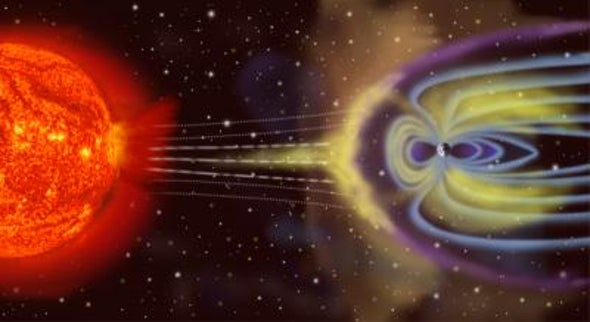(单词翻译:单击)
听力文本
This is Scientific American's 60-second Science, I'm Jim Daley.
(Audio of magnetosphere)
That strange sound? It's Earth's magnetosphere—the magnetic field created by the movement of the iron core deep within the planet. The magnetosphere is a shield, protecting us from dangerous cosmic rays. And it vibrates like a drum when jets of charged particles from the sun, called plasma, crash into it.
The theory describing this phenomenon was developed in the 1970s. But it wasn't until recently that we had the tools to observe it. In 2007 NASA launched five satellites to study the magnetosphere, in a mission called Time History of Events and Macroscale Interactions during Substorms, or THEMIS.
"We ended up making use of all five NASA THEMIS probes back very early in the mission, actually, when they were almost in a perfectly straight line."
Martin Archer, professor of physics and astronomy at Queen Mary University of London.
"And that was really ideal for trying to tease apart exactly what happens when something impulsive hits our magnetosphere."

"So basically, what happened in this particular event is really quite simple. You had a jet of plasma traveling very fast that impacted on the magnetopoles—that's the boundary of our magnetosphere. That then sent out ripples in all directions. Now, some of those will then travel toward the north and southern poles and get reflected back, and it's the interference of the original and reflected waves that allows the standing waves to form very much like the surface of a drum. And that gives it a very well-defined frequency."
Archer's team converted the signals collected by the probes into audio that we can hear. They published the discovery in the journal Nature Communications.
"From the theory behind these drumlike oscillations, we know that they should have a big effect. They should penetrate our magnetic shield quite far, causing motions within regions where there are the radiation belts, for instance. Certainly, we saw perturbations on the ground in the magnetic field and that tells us that the ionosphere is moving as well, just in the same way as the boundary is, so it's like one side of the magnetosphere is just all ringing because of this mode."
These events occur on a colossal scale—the magnetosphere extends outward about 10 times the diameter of the earth. Archer's team has proposed that future studies look into ground-based sensing methods that can reveal more about the magnetosphere's behavior. Perhaps there's an important upside in better understanding our planetary shield.
Thanks for listening for Scientific American — 60-Second Science. I'm Jim Daley.
参考译文
这里是科学美国人——60秒科学系列,我是吉姆·戴利。
(磁层的声音)
这个奇怪的声音是什么?这是地球磁层发出的声音,磁层是地球深处铁芯运动产生的磁场。磁层是一个屏障,保护我们免受危险宇宙射线的侵袭。当被称为等离子体的来自太阳的带电粒子喷射进磁层时,磁层就会像鼓一样振动。
描述这种现象的理论形成于上世纪70年代。但直到最近我们才有了观测该现象的工具。2007年,在亚暴期间事件的时间历史和宏观相互作用的任务中,美国国家航空航天局发射了5颗卫星来研究磁层。
“我们最终使用了所有5颗NASA TEHMIS卫星探测器收集到的信息,实际上在任务早期,这5颗卫星几乎完全处在一条直线上。”
伦敦玛丽女王大学的物理学与天文学教授马丁·阿切尔说到。
“对于尝试梳理冲击性物体撞击地球磁层后的情况来说,这真是非常理想的状态。”
“基本上来说,这种特殊事件的情况非常简单。移动速度极快的等离子体射流撞击磁极——也就是地球磁层的边界。之后向各个方向发出波。现在,其中一些等离子体会向南北两极移动并反射回来,原始波和反射波的干扰使驻波的情况非常类似于鼓面。这就使驻波拥有了非常固定的频率。”
阿切尔的团队将探测器收集到的信号转换成我们能听到的音频。他们将这一发现发表在《自然·通讯》期刊上。
“通过这些类似鼓面振动的理论,我们可以得知,它们应该有巨大的影响。举例来说,这些振动应该相当深地穿透了地球的磁屏障,在有辐射带的区域内引起运动。当然,我们看到了磁场地面上的扰动,这告诉我们电离层也在活动,其方式与磁层边界一样,就好像磁层的一侧因为这种模式而嗡嗡作响。”
这些是庞大规模事件——磁层向外延伸的距离约为地球直径的10倍。阿切尔的团队提出,未来研究将着眼于能揭示更多磁层行为的地基传感方法。也许这是更好理解星球屏障的重要优势。
谢谢大家收听科学美国人——60秒科学。我是吉姆·戴利。
译文为可可英语翻译,未经授权请勿转载!
重点讲解
重点讲解:
1. end up 最终;结果;到头来;
If you always give in to others you will end up feeling like a doormat.
如果你总是屈服于人,你最终会觉得自己像一个受气包。
2. make use of 使用;利用;
We should train them to make use of reference books.
我们应训练他们学会使用参考书。
3. send out 发出(信号、声音、光、热等);
The crew did not send out any distress signals.
机组人员没有发出任何求救信号。
4. convert into (使)改变;更改;(使)转变;
The signal will be converted into digital code.
信号会被转变为数字代码。


